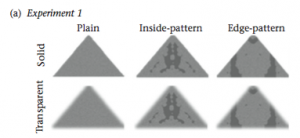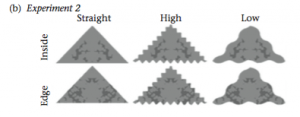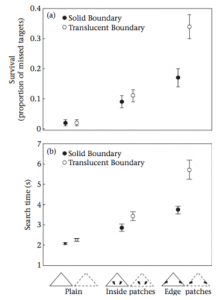Information acquired by animals from the environment, or from other individuals, reduces uncertainty about the environment, other individuals, or a future event, which allows the animal to act with confidence. Predators who use vision as a main tool of hunting must be able to distinguish their prey from the background, as well as recognize them for prey, in order to reduce their uncertainty. They do this using cues from the prey about their shape, coloration, and distance from the predator.
Disruptive coloration is a camouflage strategy that breaks up an animal’s boundaries and masks its shape, thus decreasing their detectability. Predators who look at them may not be able to recognize them without their distinct shape being obvious, and therefore would not reduce their uncertainty. Previous studies have shown a correlation between disruptive edge coloration and increased survivorship, however, the mechanism is unclear, as researchers are unsure if the protection conferred is due to edge disruption or heightened background matching. Webster et al. proposed an experiment to test if edge markings enhance survivorship by edge disruption, which would depend on how visible the animal’s edges are. To do this, they used a computer program with pictures of various triangles to represent moths and presented them to human subjects.
Some problems with this experiment may be that humans and moth’s actual predators (birds, bats, lizards, some mammals) may have different visual perceptions. Using humans instead of the natural predator may produce results that cannot be translated to the actual predators. If the actual mechanism of defensive coloration confuses the predators in a different way, humans may not be able to detect this difference. Another problem may be that they used human-created moth models, rather than models based off of moth markings seen in nature. However, the researchers were simply trying to determine the mechanism of concealment in this case, and not what actually happens in nature.
Researchers used a computer program to present pictures of the moth targets overlaid on photographs of trees, which they then presented to volunteer human subjects at a distance of 3 meters. The subjects had to click on the moth target as quickly as they could, which would determine the search time, or the amount of time it took them to distinguish the moth from the background. They also measured the number of moths that went undiscovered during each treatment, which determined the survivorship of the moths. The control was presenting a screen with no moths present.
For the first experiment, the moth models were gray triangles with different edge markings (plain, inside pattern, or edge pattern) and boundary visibility (solid or translucent), as shown. The edge pattern markings were to represent the disruptively colored moths seen in the wild.Even though the translucent edges would never be seen in nature, researchers used this method in order to test their hypothesis of whether the detection and recognition of shapes is based on edge markings that mask the edges of the shape. They used 25 different people, each of whom were presented with 60 different moth targets in random order. The moths were always in random positions on the screen with a random tree background (out of 10 total backgrounds).
The second experiment used the same edge marking patterns (either inside or edge patterns), but changed the shape of the boundary of the triangle (straight, high-frequency, or low-frequency boundaries), as seen in the picture. Again, the edge markings were used to represent disruptively colored moths, while the different borders represented perceived outline of the moth. In this experiment, they used 60 human subjects with 60 randomly presented moth targets.
They found a significant advantage in survival (overall and search time) for the models with edge pattern coloration, as well as with translucent boundaries. It took longer for the subjects to locate those models, and some were even hidden well enough to not be detected at all. The same effect of edge pattern coloration was seen in the second experiment, as well as increased survival and search time with the various shapes (as opposed to the straight-edge model). The results support the previous evidence of edge markings affecting detection by predators that use visual systems for hunting. However, these researchers directly tested disruptive coloration and showed that it is dependent on boundary markings and shape properties. Having the coloration with patterns on the edge of the boundary provided greater concealment. Having these patterns plus a translucent boundary (which would not be observed in nature) had an additive effect, which was not observed in the test with different boundary shapes. This was a surprising find, as researchers thought that both edge coloring plus uneven shapes would disrupt the recognition of the prey even more than either alone, however, this was not the case. It showed that the edge coloration pattern was sufficient for concealment, and did not require the different shaped edges.
This study provided more evidence to the disruptive coloration hypothesis, which states that breaking up an animal’s boundary marks the animals true shape, and thus prevents recognition by predators. Researchers showed that this is independent of background matching, which they originally thought may play a role in the protection of animals with edge coloration. It is just one of the many camouflage strategies that have been employed through selection by prey to deceive their predator’s visual systems. If a predator’s uncertainty about potential prey cannot be reduced by observing the animals due to its mismatched shape, then there is less of a chance of them acting to attack that prey.
Source:
Webster, R.J., Godin, J.J., Sherratt, T.N. (2015) The role of body shape and edge characteristics on the concealment afforded by potentially disruptive marking. Animal Behaviour, 104, 197-202






